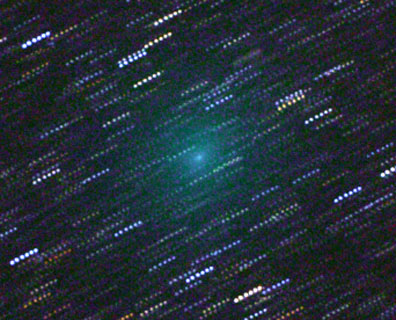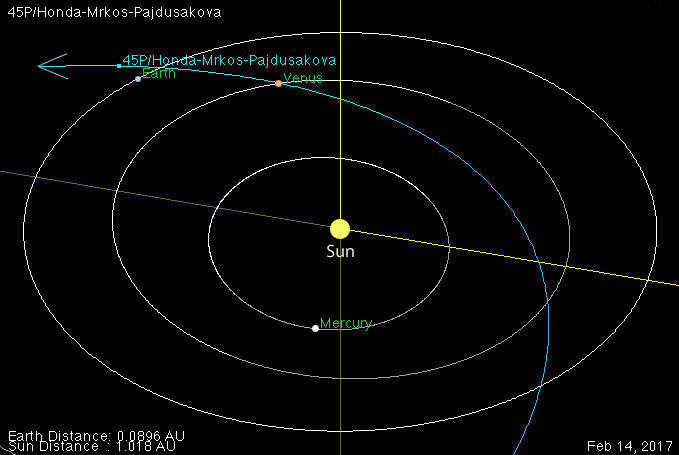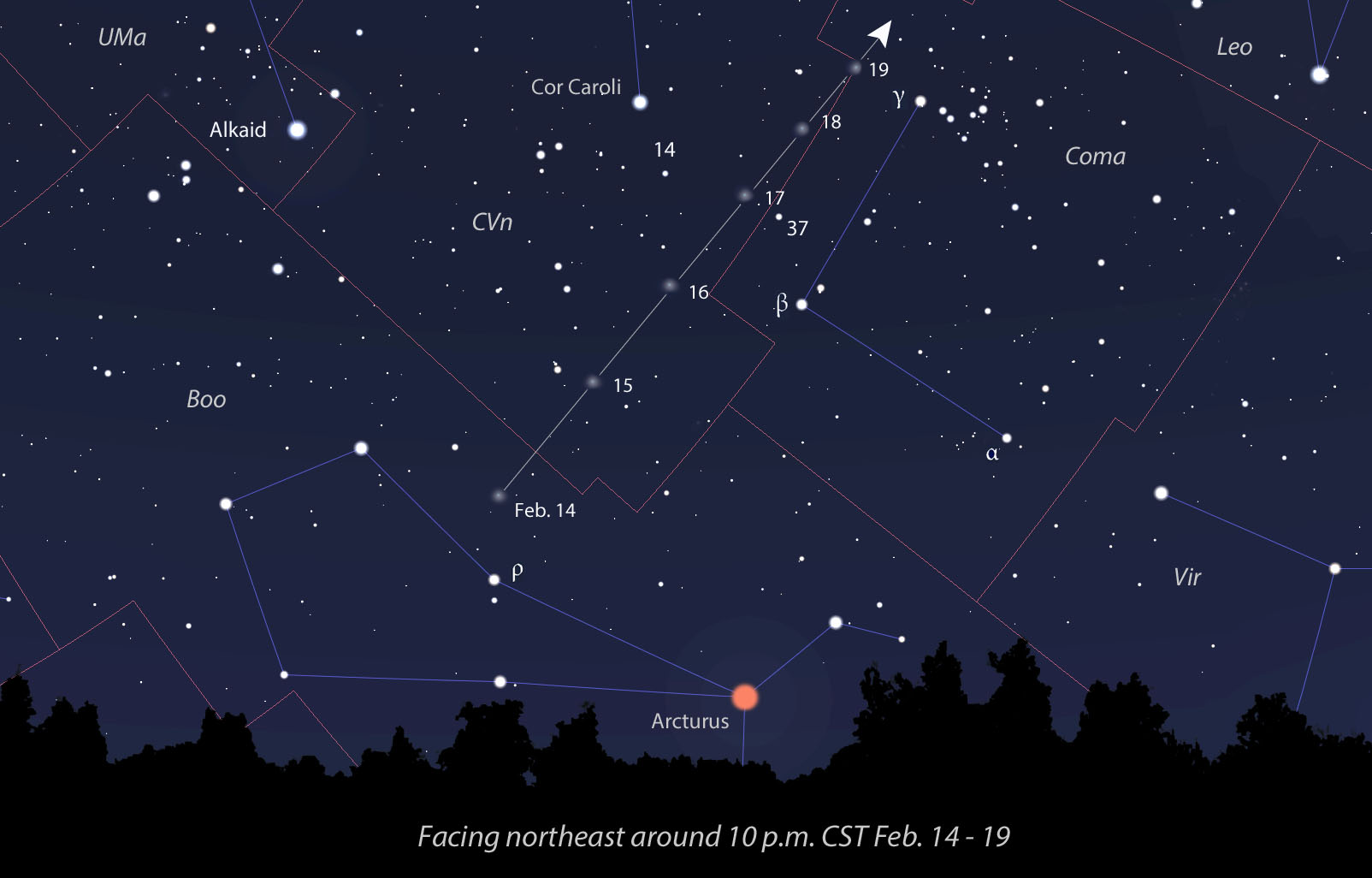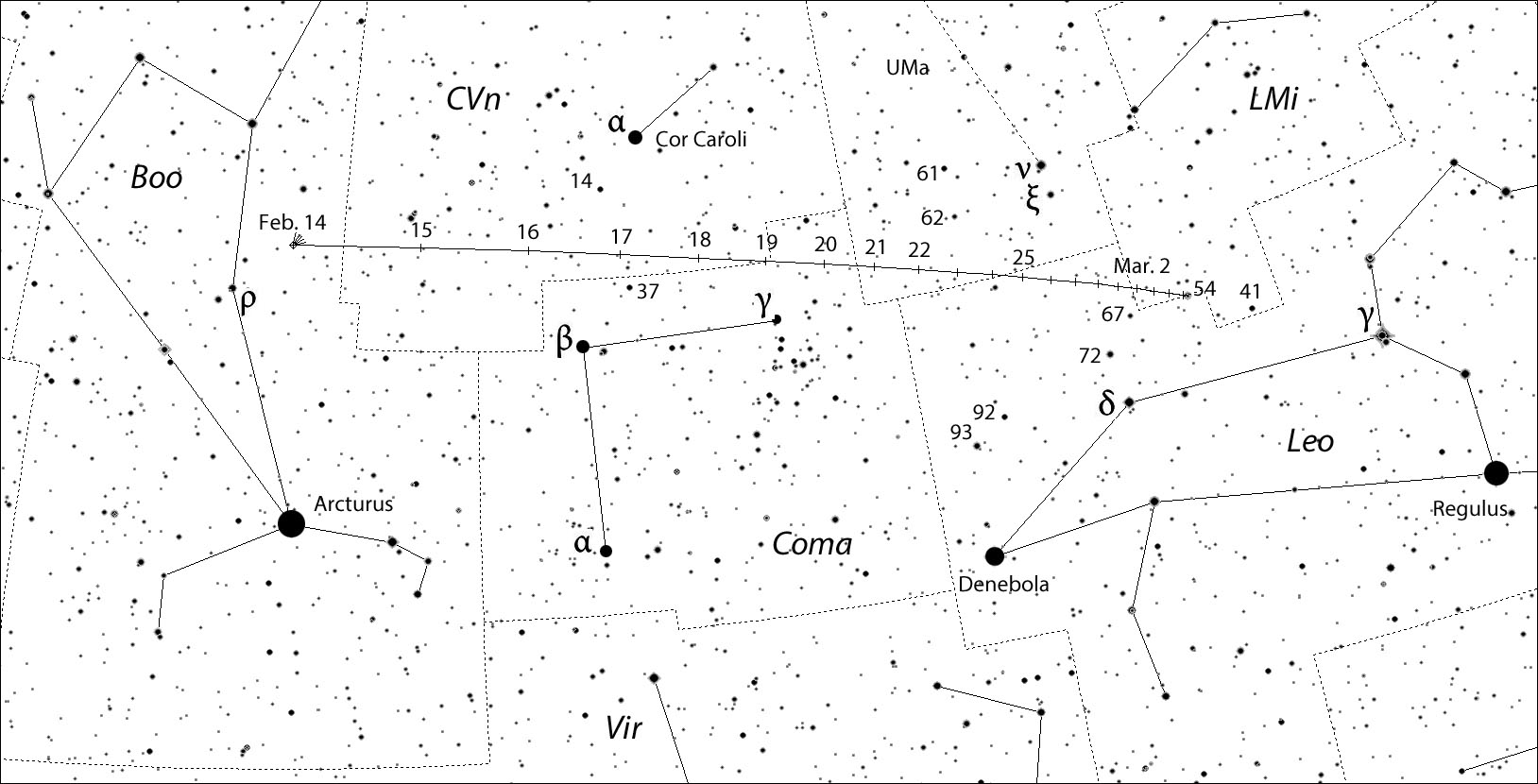After battling moonlight, Comet 45P/H-M-P returns for a final go-round in dark skies. Even better, it's up by 10 o'clock!
| Update (February 15, 2017): Arecibo Observatory has captured radar images of Comet 45P/Honda-Mrkos-Pajdusakova. It's only the seventh comet to be imaged using radar because comets rarely come close enough to Earth. Scroll down to see the radar image. |

Chris Schur
It's rare for a comet to transition from pre-dawn object to evening target in only six days, but 45P/Honda-Mrkos-Pajdusakova's proximity to Earth made all the difference. When it passed only 7.7 million miles above our rooftops on February 11th, the green blob briefly sped across the sky at up to 9° a day.
Lucky for us, it's been traveling west towards evening, while the Moon's been moving east. That's why, starting tonight, 45P/H-M-P will once again be visible in a moonless sky. On the evening of February 14th, the comet will stand about 10° high in the northeastern sky just before moonrise. Depending on your latitude, you might get as little as 10 minutes up to a half hour of dark sky. Things quickly improve later in the week as 45P rapidly gains altitude as the Moon rises later and later.
45P/H-M-P got a lot of hype last week; unfortunately, the bright Moon put the kibosh on viewing such a diffuse object for small scope and binocular users. Not only that, but the comet wasn't as bright as expected. Some predicted a peak magnitude of around +6.5, but it never got brighter than +8. Such is the nature of these cosmic fuzzballs. They can thwart our expectations, follow due course, or put on a surprise show.

NASA / JPL, with additions by the author
As we move into a moonless observing window, the comet remains spread out and tailless. Because it's well past perihelion and leaving Earth in the dust, it's expected to fade this week to around magnitude +9. That makes it fringey for 50-mm binoculars but likely still visible from a dark sky.

Map: Bob King, source: Stellarium
Telescope-toting observers will do better and enjoy views of what resembles a puff of smoke or mist, with a somewhat more "condensed" or compact central region. 45P/H-M-P still has legs! Pushing ever westward from Boötes through Canes Venatici and into Leo, on February 14th, the comet covers 6° in 24 hours, 5° on February 15–16, and 4° on Feb. 16–17. When you do find it in your telescope, take a peek a little while later, and you'll notice movement to the west at the rate of about 12′ an hour.

Created with Chris Marriott's SkyMap
The best time to view the comet in the coming week will be from around 10–11 p.m. local time, when it's well placed in the eastern sky. 45P/H-M-P should fade rapidly by late February, so be sure to see it while you can. At its next bright return in October 2032, the comet's expected to reach magnitude +7. I'll keep an eye on it, so check back here for an update in a day or two. Happy hunting!
** UPDATE: Great news! I was able to spot the comet in 10x50 binoculars 15 minutes before moonrise tonight (Feb. 14). It appeared quite large — about 30′ or a full moon diameter wide — but of course faint and very diffuse with an estimated magnitude of +8.3. In just a night or two, the comet will be considerably higher before moonrise and a little bit easier to see.
** UPDATE #2: The Arecibo radio dish spotted the comet too! Instead of visual observations, Arecibo captured radar images of the comet as it flew by Earth, making it the seventh comet to be imaged by radar. The image below shows 13 images collected over two hours of observation.

 25
25









Comments
Graham-Wolf
February 14, 2017 at 8:47 pm
Great work, Bob.
45p/H-M-P fever all round.... may they never find a cure. This is comet watching, as it should be. The charts are great, if indeed upside-down and back-to-front for us in the Antipodes, but "Stellarium" certainly comes to the rescue. The comet's large green coma reminds me somewhat of C/1996B2 Hyakutake.... the 3rd closest comet to whizz past the Earth. Recall also seeing IRAS-Iraki-Alcock in 1983, but certainly wasn't around for Lexell in 1770. This apparition of 45p may be my 6th or 7th. Having so much off a buzz, just can't be bothered counting.
Regards from 46 South, NZ.
Graham W. Wolf.
You must be logged in to post a comment.
Bob KingPost Author
February 14, 2017 at 10:46 pm
Graham,
Your enthusiasm is infectious! I just got in from viewing the comet in 10x50s. It's still hanging in there around +8.3. Very large and diffuse and headed (eventually) to a sky near you!
You must be logged in to post a comment.
Imad
February 2, 2018 at 4:53 am
Mr. Bob,
As a student, i have a standardized "research" project and i chosed astronomy as a subject. The aim of the project is the study of the trajectory of the Comet 45P/Honda–Mrkos–Pajdušáková and a part of it consists in image processing.
So please I need to obtain a raw picture of the comet especially around the night of 10 to 11 february 2017 to process it with respect to the rights on the picture.
Thank you for your help.
You must be logged in to post a comment.
Aqua4U
February 15, 2017 at 2:28 pm
Thanks for the updates and maps! I'm still hoping to see this comet as I've tried several times but have been clouded or rained out so far. Am hoping for a hole in the clouds, but that looks iffy at best? We've been getting slammed by storm after storm here in Northern California. Then when a clear spot DID appear the full moon blew away that off.
I'd love to see this comet in the 12X70 SkyWatcher binocs I got for x-mas! A 'proper' introduction? Then if the hole is big enough I'll roll out my 12 1/2" to get up close and personal with it! Now where did I put those weather change cards I had?
You must be logged in to post a comment.
Aqua4U
February 15, 2017 at 2:32 pm
Back in the early 90's I belonged to an astronomy club at a ranch near Lake Berryessa, CA. There were usually 4-6 kids running around. Anyway, when the clouds threatened I'd line up the kids and have them all blow as hard as they could at the clouds. GO AWAY!
Hey... don't laugh. It worked! Go figure...
You must be logged in to post a comment.
Bob KingPost Author
February 15, 2017 at 3:05 pm
Hi Aqua,
I bet you're itching to try those out. A perfect match for the comet's current size and appearance. Clear skies my man!
You must be logged in to post a comment.
Capella80
February 15, 2017 at 8:33 pm
Good article! Hope bortle 5 skies and 80mm is all I need!
You must be logged in to post a comment.
Bob KingPost Author
February 15, 2017 at 10:06 pm
Thanks Capella80. Clear skies and good luck!
You must be logged in to post a comment.
Graham-Wolf
February 16, 2017 at 6:30 pm
Hi Bob.
Your latest Mv 8.3 report noted... can't wait to "nail" the comet again.
Will have to wait a few more days down here at 46 South, for the Moon to rise much later, and the region near Arcturus also to rise. Comet is still too far north for us, at present. At 10:50 UT last night, stepped outside to see Last Quarter Moon about 20 deg up in the East and to the right and lower of Jupiter. My best guess for my next window for 45p, will be Feb 21st - 25th. I've been running more Stellarium simulations on the laptop to make sure. Great that you folk in the northern hemisphere are seeing it already. It sure helps extend that enviable data curve.
Still impressed with your Feb 5th astropic. It's a beaut!
Like you, I am also a mild-tech "point and shoot astro-photographer". Your own pic roughly equates to ~10s at 1600 ISO. I use a Canon A480 Compact, and do 10s and 15s at 35mm efl, ISO 1600, F3. I also use a 2s shutter delay, to reduce "shake". Multiple shots taken, with appropriate Darks and Flats, then processed with "Deep Sky Stacker" just might get down to ~ Mv 10. Good luck with any further efforts, Bob.
Regards from 46 South, NZ.
Graham W. Wolf.
You must be logged in to post a comment.
Bob KingPost Author
February 17, 2017 at 2:06 pm
Hi Graham,
Good luck on a sighting of the comet. Sounds like we shoot astropix similarly. What stacking program do you use and is it for Mac or PC?
You must be logged in to post a comment.
Bob KingPost Author
February 18, 2017 at 1:21 am
The comet hanging in there - still easily visible in 10x50 binoculars tonight (Feb. 17-18) high in the southeastern sky in Canes Venatici.
You must be logged in to post a comment.
Capella80
February 18, 2017 at 8:39 pm
Oh well, never got to observe 45p anyways. Clouds moved in with some showers last night. Last observing session I got up early and observed from 4 to 6 in the morning, totally forgot I was waking that early to observe HMP. (It still wasn't bad. Iridium flares, the ISS, Jupiter bands, Jovian and Saturian satellites, M13, various doubles, and speaking of satellites, I almost fell over when a satellite passed front of Alpha Vupecula.) Maybe I'll try to get a good look of 2P/ Encke. Unlike the saying "March, in like a lion, out like a lamb", it tends to be the opposite in Nashville. Might want to get some observing in.
From 36° North, -Capella.
You must be logged in to post a comment.
Graham-Wolf
February 19, 2017 at 6:12 pm
Hello Bob.
I've tried "Registax V4, V5, and V6 and just keep falling over with the software!
I've also tried Deep Sky Stacker (freeware) for the PC... single files start running into the hundreds of Mb, and are just too big to post over the Net, Trying to resolve that issue!. There may be a MAC version, but I'm not sure. I've used the Deep Sky Stacker methods outlined in a recent Sky and Telescope!! (Astro-photo) column, with some success, but faced with huge file sizes. Gives the multi-core processor a jolly strenuous workout... more sweat than Jane Fonda! I'm not too good at converting Jpegs to RAW etc. However for stacking, I recommend the following (personal minimums). Most of this resulted from personal try-and-see to at least get into the "ball park".
1. Max your MPx size... especially if you intend to crop later, Bob. My Canon A480 maxes out at 10.3 Mpx. I've done 6Mpx and 3Mpx, but prefer the max size.
2. Take at least half a dozen darks just before you start, at the exposure and ISO you will be using out in the field.. say 15s at ISO 800.
3. Take at least 2 darks after each photo run,
4. Run your lens wide open (F3.0 for me) or stop down 1 f stop, if using a very fast DSLR.
5. A 2s shutter delay for each exposure.
6. Take say 12 shots, then a series of flats. The image will dither, which also helps!
7. When you wake up in the morning, take a series of brights..... up into a clear sky at the same exp and ISO as you did at night time.
8 A typical routine might be....
10 Darks
12 Shots.
4 Darks
12 Shots.
12 Lights.
Load into DepSky Stacker... hang on for dear life, and pray!
Currently, Bob, I just take-it-easy. 15s at 1600 ISO, single shot at f3.0. Tweaked in MS Image Manager (via OFFICE 2007). Stretch the brightness, contrast, and mid-tone. to lift the image out a little.
Got a faint look at 45p just a few hours ago ! ~ 14:40am NZDT. Dropped 30 deg below Jupiter, and 30 deg left. Some Lunar pollution low to the East... a Last Quarter Moon. Double checked by taking a line downwards from Saturn through Jupiter to the NE local horizon ... just a little left of Mt Grand overlooking Abbotsford. Used HIP stars within ~ 1 deg radius of comet as follows... HIP 60535 (7.50), HIP 60367 (8.25), HIP 60373 (8.90). It has certainly faded considerably within the last fortnight or so! Weather for next 2 -3 days not good.... we'll, see, Bob.
Following data:- (via LIADA)... mine not posted.
Feb 16.96 UT Mv 7.5 15 arcmin DC2 10x50B SUAREZ (Spain)
Feb 19.00 UT Mv 8.3 &10 arcmin DC1/ 25cm L 64x MEYER (Germany)
Feb 19.569 UT Mv 8.2 12 x 10 arcmin DC2 12cm L 50x (96' FOV) WOLF (NZ)
Keep up the great work, Bob!
Regards from 46 South, NZ.
Graham W. Wolf
You must be logged in to post a comment.
Martian-Bachelor
February 20, 2017 at 4:51 pm
Bob,
I've got a time-lapse video of Comet 45P covering ~1 hour from Thursday night local time (5:30-6:30AM GMT the 17th), taken with a Canon 'pro-sumer' DSLR and 200mm lens.
It's 74 frames long, so it only runs ~5 seconds. But with a digital zoom-in to a field of view of ~5/8° x 5/6° you can really see the comet move along quite nicely.
We've hardly had a gap in the clouds around here for months, so I was quite pleased to get something/anything.
It's not quite as cool as Arecibo, but then I'm not publicly funded... is this anything S&T would pay some small amount for to have on its website? If so, where should I send it?
* MB
You must be logged in to post a comment.
Bob KingPost Author
February 20, 2017 at 8:00 pm
Hi Martian-Bachelor,
Happy to hear the results were good. Any chance you have a link (or youtube upload) for us to see?
You must be logged in to post a comment.
Martian-Bachelor
February 22, 2017 at 3:30 pm
Nyet,
The only copy is on my computer. Like other indie content producers I have a thing about just giving it to someone else's computer, even if I'm the only one who supposedly has access.
2 years ago I contacted someone in PR at JPL whose name was on a news piece about the close approach of Asteroid BL-86 (I'd gotten 5 hours of excellent stuff of it going by the Beehive Cluster), asking about where there's a market for footage like this -- besides just putting it up on wikipedia for free -- but he never got back to me.
Here's a link to other astronomical work I've been doing: visns.neocities.org .
You must be logged in to post a comment.
Graham-Wolf
February 20, 2017 at 11:08 pm
Hi Bob
Another view of 45p this morning.
Dropped down 30 deg below Jupiter, hung a 30 deg left-hander, scanned along the NE horizon, (as for yesterday). This time, the waning crescent Moon below the horizon. The comet seems to have flared ~ 1/2 Mv since yesterday. Same HP (Hipparchus) Check stars as yesterday. Had another look at 2:40am NZDT, as the Moon was starting to peek over the Eastern Horizon nearby.
Comet seems to have flared ~ 1/2 MV since yesterday morning, down here!
Also, a reasonable view in the 20X80mm Polarex "Spotterscope" (f4 Achromatic Refractor) 2.0 df.
FEB 20.542 UT Mv 7.6 18x16 arcmin coma (to ~ Mv 10 1/2) DC2 12L f8 50x (96" FOV)
Chris Wyatt, observing with a 7x50B from Walcha, NSW, got a similar Mv and coma estimate as myself ~ 1 hr later. FYI. Regards from 46 South, NZ. Graham W. Wolf
You must be logged in to post a comment.
Bob KingPost Author
February 21, 2017 at 12:14 am
Graham-Wolf,
It may have brightened as you suggest based on Chris's estimate. Thanks for the info on stacking!
You must be logged in to post a comment.
Graham-Wolf
February 21, 2017 at 11:01 pm
Thanks, Bob.
Main scope used is a 12cm f4 Meade GOTO Newtonian, with a 20mm termi-nagler and 2x Meade shorty barlow. I can also extend to 3.5x Barlow equivalent. This gives 88x and 55 arcmin FOV. Also "sharpens" up the light cone. Chris uses a 25cm f5 GSO dielectric coated Dob, at Walcha, NSW. I used to own one myself until stolen early May last year in the Hutt valley, NZ... great machines ~ equal to a 32cm normally alumunised primary, in terms of light grasp...
Clouded out this morning, but in recent days, Chris and I have also been independently looking at an outburst of 73p/ S-W-3. Excitement caused by a new (?) fragment called BT, violently out-gassing, methinks. FYI for your readers out there. I remember this comet erupting in the mid 1990's.... quite a (brief) naked eye sight back then!
Christchurch bush-fires now out, but Port Hills a charred mess, and "hot spots" being still monsoon bucketed. 3000 hectares lost, one chopper pilot killed, and a dozen or so homes destroyed. Huge fire-ban continues over most of NZ. 32 deg C unofficially down here yesterday, only mid 20s today! Regards from 46 South, NZ. Graham W. Wolf.
You must be logged in to post a comment.
Bob KingPost Author
February 22, 2017 at 12:27 am
Graham-Wolf,
I've been reading about the fires. Sorry to hear about that. Glad you've been keeping an eye on 73P and BT fragment. I wish they were higher up for me, but I have great memories of tracking the bright fragments of 73P back in the 90s. What a display that was!
You must be logged in to post a comment.
Graham-Wolf
February 26, 2017 at 7:52 pm
Hello Bob
Just back from a laborious (but enjoyable) non-stop 2 day national disaster simulation (Ham Radio comms exercise). I'm (Grade I) ZL2-CHAR.
Living rough in damp weather and high winds in a huge farm paddock and small dome tent along the South Otago Pacific Ocean coastline~ 2km inland , with a noisy 5Kw generator only metres nearby! Skies cleared on Sunday morning after ~ 3am to be a magnificent ZLM 7.0! Could see M4 in Scorpius naked eye at 60+ deg elevation (the sort of Bortle Class skies I really like)! And, on the zenith, was my good old "friend" the Southern Cross. Could not quite make out +7.2 or +7.4 stars around Epsilon Crucis. 45p has certainly had a massive fade these last two days.
The +7.0 skies made it a test to acquire 45p in 10X50s... a rather better view was had in the 20x80R. Aperture certainly makes the difference. I had kipped out in the tent for 4 hours, so was well dark adapted... Jupiter was almost too painful to look at! Back home this morning ~ 5am local time, the comet had swung round to the North and was half-way between Arcturus and Spica, and at a much better elevation. Now using AAVSO-VSP Custom Chart:- (12df MLim 12, around Spica). That should also suffice for March.
My data FYI:-
Feb 25.653 UT Mv 10.2 15 arcmin coma DC1/ 10x50B 10x ZLM 7.0 WOLF
25.667 UT Mv 10.0 18.2 arcmin DC1 20x80 R 20x ZLM 7.0 WOLF
Feb 26.667 UT Mv 10.8 10.4 arcmin DC1 12cm f4 L 50x ZLM 6.2 WOLF
On the 25th, thought I could see a faint tail ~ 0.3 deg, PA 250 to Mv 11, but not quite sure. Would really have needed the 12cm f4 to confirm, but that was left at home.
Polish observer reports a 0.5 deg tail at PA 250 with 10x50B and Mv 8.8, on Feb 24.98UT.
For typical suburbia, I'd be recommending rolling out that old faithful 4 1/2 inch f8 Newtonian and low power, maybe even more aperture, and a Mv 6+ sky, from here on. Maybe, 100x for close up tail structure observations, but keep it 30 - 50x and 60+ arcmin FOV if possible...
Best wishes (as always) to your readers.
Keep up the awesome work, Bob!
Regards from 46 South, NZ.
Graham W. Wolf
You must be logged in to post a comment.
Graham-Wolf
February 28, 2017 at 10:18 pm
Hi there, Bob!
My latest update on 45p...
Latest personal data for 45p H-M-P. from the Fairfield Quarry Darksite (FQD).
ZLMs in clear moonless skies (as at present!!) are 6.2 to 6.4.
Scope is A 12cm f4 Meade GOTO Newtonian, with a 20mm "termi-Nagler" with a 2x Meade Shorty Barlow. This gives 50x and 96 arcmin FOV. With 3.5x Barlow extension, I get 88x and 55 arcmin FOV.
Feb 26.667 UT Mv 10.8 10.4 arcmin DC1 WOLF, NZ
Feb 27.667 UT Mv 8.8 14.6 arcmin DC1 WOLF, NZ
Feb 28.653 UT Mv 9.8 23.2 arcmin DC 1 WOLF, NZ
My "AC" comparison stars are from a customised AAVSO-VSP Chart (12df MLim 12, centred on Spica).
Sidegwick method "S" was used. No tail structure seen down to the Mv12 limit of my Charts.
Also continuing to monitor the BT fragment of 73p S-W-3.
It's steadily brightening, and does not seem to have "maxed out", yet.
Enjoying a long run of continuous fine clear nights... while they last!
FYI.
Regards from 46 South, NZ. Graham W. Wolf.
You must be logged in to post a comment.
Bob KingPost Author
March 1, 2017 at 1:14 am
Nice data set, Graham. I got a look in 10x50 binoculars two nights ago on Feb. 27.1 UT, and the comet was quite faint (around mag. 8.5) but still plainly visible. In my 37-cm scope, I estimated the coma diameter at 20 arc minutes, DC=1 and saw a faint, wide ~30 arc minute tail to the west-northwest. The BT fragment is only 6 degrees high at the start of dawn for me, but knowing it continues to brighten may mean I'll have to take a swing at it one of these mornings.
You must be logged in to post a comment.
Graham-Wolf
March 2, 2017 at 7:48 pm
Hi Bob.
Latest data-set from me for 45p.... this time for March.
A great run of good clear nights, down here in Otago, NZ. rain forcast for next 3 days straight...
12cm f4 Meade GOTO. 20mm Termi-Nagler and 2x Meade Shorty Barlow = 50x and 96 arcmin FOV.
AC Comparisons from customised AAVSO-VSP Charts (12df MLim 12 around Spica).
Mar 01.583 UT Mv 9.8 8x20 arcmin coma DC2 10 arcmin tail to Mv 12 50x 96' FOV WOLF, NZ.
Mar 02.646 UT Mv 8.6 12x18 arcmin coma DC2 No tail to Mv 12. 50x 96' FOV WOLF, NZ.
41p (T-G-K) was mid 10th Mv just a few hrs ago this morning (NZDT) with a 1.6 arcmin DC2 coma at 88x with the Meade GOTO. FYI.
Increasing lunar pollution will hassle in evening skies over forthcoming days, then early mornings later this month. Looking forward to 2p/Encke at end of the month.
Regards from 46 South, NZ.
Graham W. Wolf.
You must be logged in to post a comment.
Bob KingPost Author
March 3, 2017 at 9:38 am
Graham-Wolf,
You get to keep Encke for a while as we lose it here in the north. I did spot it very low last weekend -- very condensed and fairly bright at mag. ~8.5. Again, thank you for sharing your observations!
You must be logged in to post a comment.
You must be logged in to post a comment.